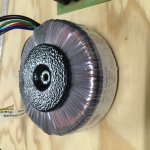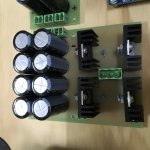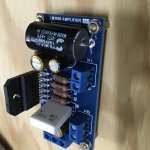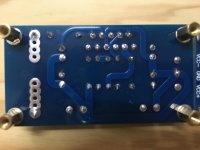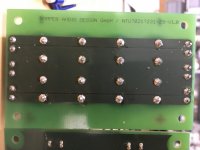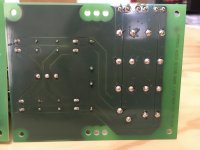Hi friends
I received a diy-kit of a lm3886 dual mono poweramp (this one: 2x LM3886 68W Power Amplifier Kit (Mono)_Solid-State Amp_Analog Metric - DIY Audio Kit Developer)
The amplifiers are quite simple. For the PSU, there‘s a 2 x 24V 200VA toroid and 2 x 8 1000uF Elna capacitors...
Being a noob with ambitions, I ask myself wether anything should be improved on the basic design? Any tips welcome!
Complications will probably come with the details...
David
I received a diy-kit of a lm3886 dual mono poweramp (this one: 2x LM3886 68W Power Amplifier Kit (Mono)_Solid-State Amp_Analog Metric - DIY Audio Kit Developer)
The amplifiers are quite simple. For the PSU, there‘s a 2 x 24V 200VA toroid and 2 x 8 1000uF Elna capacitors...
Being a noob with ambitions, I ask myself wether anything should be improved on the basic design? Any tips welcome!
Complications will probably come with the details...
David
Attachments
Hi David,
Are there the almost-mandatory zobel and thiele network?
For the Thiele network I suggest you a 2,2 ohm resistor (rated at least 3W. Or you can parallel resistors with higher resistance, if you want a safer power rating) and a 1,2uH inductor. If you don't like the idea of building yourself an air core inductor, choose one with a respectable saturation current. I strongly believe it is not mandatory to use an air core inductor. Just take care of the saturation current.
The Zobel network works fine with the most common values, like 2,7 Ohm and 100nF.
It's likely that you already know this site, but if you don't... it is absolutely a mandatory reading, it's written by a member of this forum, which is almost (hey, it's not my intention to understate other members' expertise 😛 ) for sure the best expert about lm3886:
Taming the LM3886 Chip Amplifier – Neurochrome
It looks like your boards don't include the "optional stability components". The site linked talks about those components. It's highly recommendable to add them. Adding them on the back side of the board might not look very good, but I suggest you to give it a try.
Cheers!
Are there the almost-mandatory zobel and thiele network?
For the Thiele network I suggest you a 2,2 ohm resistor (rated at least 3W. Or you can parallel resistors with higher resistance, if you want a safer power rating) and a 1,2uH inductor. If you don't like the idea of building yourself an air core inductor, choose one with a respectable saturation current. I strongly believe it is not mandatory to use an air core inductor. Just take care of the saturation current.
The Zobel network works fine with the most common values, like 2,7 Ohm and 100nF.
It's likely that you already know this site, but if you don't... it is absolutely a mandatory reading, it's written by a member of this forum, which is almost (hey, it's not my intention to understate other members' expertise 😛 ) for sure the best expert about lm3886:
Taming the LM3886 Chip Amplifier – Neurochrome
It looks like your boards don't include the "optional stability components". The site linked talks about those components. It's highly recommendable to add them. Adding them on the back side of the board might not look very good, but I suggest you to give it a try.
Cheers!
Last edited:
... zobel and thiele network
Taming the LM3886 Chip Amplifier – Neurochrome
"optional stability components"
Cheers!
Sregio,
It looks like you looked at everything very thoroughly. Thank you very much, I appreciate it a lot!
I (of course 🙂 ) knew neurochrome's great website, but haven't read through it all. I got attracted by his detailed explanations about heat-control. Now I have my read through the rest of the articles for sure!
It may take a while until I got through, and surely more questions will emerge.
Again, mille grazie!
all the best
david
There have been plenty of amplifiers with off-board Thiele and Zobel networks (at times right at the speaker terminals), that's not so much of a problem.
We would need pictures of the underside of the boards to see whether the layout is any good.
Parts quality looks good, I just have to wonder which board designer is crazy enough to include a massive 1 µF / 1400 V= MKP input capacitor.
We would need pictures of the underside of the boards to see whether the layout is any good.
Parts quality looks good, I just have to wonder which board designer is crazy enough to include a massive 1 µF / 1400 V= MKP input capacitor.
Looks like the XY board from eBay with upgraded resistors and input capacitor.
I would bring the power supply decoupling up to the recommendations given by National Semiconductor / TI in the LM3886 data sheet (see the application section) as a minimum. Or follow my recommendations: Taming the LM3886: Power Supply Decoupling – Neurochrome
Without proper decoupling, the LM3886 will oscillate at higher output current (so near signal peaks, especially with 4 Ω load).
As others have pointed out, the "optional stability components", Zobel, Thiele networks should be added as well for the best stability. If you choose to add a Thiele network (L||R in series with the output), you can get rid of the power resistor that's currently in series with the output. That'll give you higher output power and lower distortion.
Tom
I would bring the power supply decoupling up to the recommendations given by National Semiconductor / TI in the LM3886 data sheet (see the application section) as a minimum. Or follow my recommendations: Taming the LM3886: Power Supply Decoupling – Neurochrome
Without proper decoupling, the LM3886 will oscillate at higher output current (so near signal peaks, especially with 4 Ω load).
As others have pointed out, the "optional stability components", Zobel, Thiele networks should be added as well for the best stability. If you choose to add a Thiele network (L||R in series with the output), you can get rid of the power resistor that's currently in series with the output. That'll give you higher output power and lower distortion.
Tom
… pictures of the underside of the boards to see whether the layout is any good.
… which board designer is crazy enough to include a massive 1 µF / 1400 V= MKP input capacitor.
Guten Abend sgrossklass
Thank you. As soon as I'm back in the atelier, I'll send a pic of the underside... (my guess is it'll be ok. but I couldn't tell.)
Is the crazy input cap just crazy, or is it more like a problem?
Good evening TomI would bring the power supply decoupling up to the recommendations given by National Semiconductor / TI in the LM3886 data sheet (see the application section) as a minimum. Or follow my recommendations: Taming the LM3886: Power Supply Decoupling – Neurochrome
Without proper decoupling, the LM3886 will oscillate at higher output current (so near signal peaks, especially with 4 Ω load).
…add a Thiele network (L||R in series with the output), you can get rid of the power resistor that's currently in series with the output. That'll give you higher output power and lower distortion.
Tom
Thanks for looking into it! I'm in fact working through your article, trying to get a grasp of what/where to look... (I also was considering ditching this actual amp and replace it with your 3886DR 😉 — I shall see in the near future)
I'll try to understand what I have been told here, and try again, and then I might come back and ask further questions if I don't get it. So it will be a while...
In the meantime, thanks very much to all!
david
PS can't repeat it enough: this community is really very very 😎
We would need pictures of the underside of the boards to see whether the layout is any good.
sgrossklass,
here's fotos of the boards underside...
Thanks for looking into it!
Attachments
- Home
- Amplifiers
- Chip Amps
- Analogmetric Lm3886 68W Mono — anything to improve?
